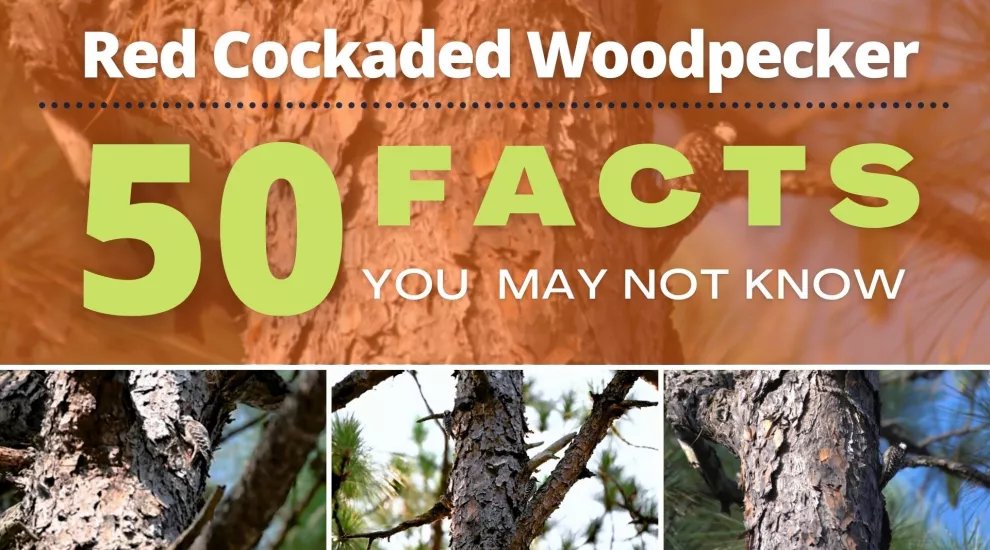
South Carolina is the home to numerous bird species across different regions of the state. However, none is more important to the state’s ecosystem and its Sandhills region than the Red Cockaded Woodpecker.
The Sandhills region is an area of rolling hills and clay/sand features that is located between the Piedmont and Coastal regions of the Palmetto State. The Sandhills is most notable for its strong environments and creatures that live in the area.
The Red Cockaded Woodpecker is one of several birds from the woodpecker family that is best known for its black and white patches, as well as its small red feather features on the back of its head.
If you are familiar with red cockaded woodpeckers or not in addition to their impact on South Carolina, here are 50 fun facts about them!
Alongside the Red Cockaded Woodpecker, there are around 437 bird species in South Carolina.
Red cockaded woodpeckers adapted from the age of dinosaurs and are common in a lot of places as well as South Carolina.
Red cockaded woodpeckers come from a distinctive list of the woodpecker family that has a wide range of shapes and colors.
Red cockaded woodpeckers have the strong ability to fly long distances with their wings and females can lay several eggs during a season.
Red cockaded woodpeckers prefer to drink water that is collected on leaves rather than on water surfaces and streams.
Red cockaded woodpeckers are one of the few animals that have the capacity to deal with tree cavities.
Red cockaded woodpeckers use a variety of different noises to communicate with other animals.
It can take anywhere between one to three years for red cockaded woodpeckers to treat cavities in longleaf pine trees.
There is currently a 4% population growth rate in South Carolina for red cockaded woodpeckers.
Red cockaded woodpeckers can produce one to five eggs per nesting season.
Red cockaded woodpeckers oftentimes live together in small families within their nests.
Male woodpeckers serve as extra birds from previous breeding seasons to help participate in the breeding process.
Female woodpeckers oftentimes never stay with their families after breeding seasons and will instead go on to start new ones on their own.
Red cockaded woodpecker eggs are laid in the cavity of the longleaf pine tree.
Male woodpeckers are responsible for incubating longleaf pine trees at night.
Red cockaded woodpeckers can range from 1.5-1.8 ounces in weight.
Red cockaded woodpeckers can be as tall as 7.9-9.1 inches in height.
Red cockaded woodpeckers live on longleaf pine trees that are between 80-100 years old.
The average lifespan of a Red Cockaded Woodpecker is around 12 years old.
If necessary, red cockaded woodpeckers can migrate to other areas if they deem their environment to be too dangerous to live in.
Migration is the seasonal movement of animals from one region to another.
In most instances, despite in the situation that unforeseen challenges come up, most red cockaded woodpeckers like to stay around in the environment they settle in originally.
Compared to other organisms in the state, red cockaded woodpeckers live in a distinctive and unique habitat.
Because of this, red cockaded woodpeckers can live a wild lifestyle each day.
Most red cockaded woodpeckers in South Carolina reside in the Sandhills region.
Prior to the red cockaded woodpeckers calling it home, the Sandhills region was once the site of where South Carolina’s beaches once stood.
In addition, the Sandhills region was affected by the Ice Age period, playing a major factor on why the red cockaded woodpeckers have thrived in the region.
The Sandhills is home to an incredibly unique ecosystem that the red cockaded woodpecker calls home which includes rare wildlife, rolling hills, and pine trees.
Rain fall dries up rapidly over time in the Sandhills region, but it has no effect on red cockaded woodpeckers.
Longleaf trees are one of the major features for red cockaded woodpeckers and the Sandhills region.
Red cockaded woodpeckers and the Sandhills often experience lightening lire throughout the course of the year.
With the help of man-made burning, the Sandhills have experienced strong ecosystems that have strongly benefited red cockaded woodpeckers.
Red cockaded woodpeckers rest in longleaf pine trees mainly because of their adaptation overtime and their fire-resistant bark.
One major reason that red cockaded woodpeckers reside in longleaf pine trees is due to their production of pine resin.
Pine resin helps protect the woodpeckers’ nest against nearby predators in the area.
The Red Cockaded Woodpecker gets its name from its red strip that is mostly behind male birds.
The main lifestyle of red cockaded woodpeckers is working in clans to work on several longleaf pine trees.
The social system of a Red Cockaded Woodpecker’s life involves both a male and female pair working together.
Other red cockaded woodpeckers will be involved in the system of offspring by building new nests and raising babies when necessary.
When picking longleaf trees to build their nest, red cockaded woodpeckers will pick those with red heart disease.
Red heart disease is a fungal infection that causes the wood of longleaf pine trees to rot, which allows the woodpeckers to peck holes easier.
Despite their successful surroundings in the Sandhills, red cockaded woodpeckers have faced the challenges of deforestation.
Deforestation is the act of clearing an area with trees and animals like the woodpeckers for other uses.
As a result, the Red Cockaded Woodpecker became one of the first species on the planet to be considered endangered.
Because of these challenges, wildlife management in South Carolina has helped preserve the population of the Red Cockaded Woodpecker in several ways.
Workers have built artificial nests in longleaf pine trees for woodpeckers so that they can have longer lifespans.
Workers are also using white marks in certain longleaf pine trees in order to collect activity and data made by the woodpeckers.
With the new artificial nests, cameras have been put in place to track movements made by the red cockaded woodpeckers.
With many resources in place by many wildlife organizations, red cockaded woodpeckers have begun to make a recovery throughout the Sandhills region.
For more information about red cockaded woodpeckers in South Carolina, be sure to visit our What’s Wild program on these creatures for a more digitalized look!
{"preview_thumbnail":"/sites/default/files/styles/video_embed_wysiwyg_preview/public/video_thumbnails/kDbPbHdwl0E.jpg?itok=Aa5xQM4v","video_url":"https://youtu.be/kDbPbHdwl0E","settings":{"responsive":true,"width":"854","height":"480","autoplay":false},"settings_summary":["Embedded Video (Responsive)."]}





